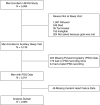Sleep-disordered Breathing and Incident Heart Failure in Older Men
- PMID: 26502092
- PMCID: PMC4824922
- DOI: 10.1164/rccm.201503-0536OC
Sleep-disordered Breathing and Incident Heart Failure in Older Men
Abstract
Rationale: The directionality of the relationship between sleep-disordered breathing and heart failure is controversial.
Objectives: We assessed whether elevations in the obstructive or central sleep apnea index or the presence of Cheyne-Stokes breathing are associated with decompensated and/or incident heart failure.
Methods: We conducted a prospective, longitudinal study of 2,865 participants derived from the Osteoporotic Fractures in Men Study, a prospective multicenter observational study of community-dwelling older men. Participants underwent baseline polysomnography and were followed for a mean 7.3 years for development of incident or decompensated heart failure. Our main exposures were the obstructive apnea-hypopnea index (AHI), central apnea index (CAI ≥ 5), and Cheyne-Stokes breathing. Covariates included age, race, clinic site, comorbidities, physical activity, and alcohol and tobacco use.
Measurements and main results: CAI greater than or equal to five and presence of Cheyne-Stokes breathing but not obstructive AHI were significant predictors of incident heart failure (adjusted hazard ratio [HR], 1.79; 95% confidence interval [CI], 1.16-2.77 for CAI ≥ 5) (HR, 2.23; 95% CI, 1.45-3.43 for Cheyne-Stokes breathing). After excluding those with baseline heart failure, the incident risk of heart failure was attenuated for those with CAI greater than or equal to five (HR, 1.57; 95% CI, 0.92-2.66) but remained significantly elevated for those with Cheyne-Stokes breathing (HR, 1.90; 95% CI, 1.10-3.30).
Conclusions: An elevated CAI/Cheyne-Stokes breathing, but not an elevated obstructive AHI, is significantly associated with increased risk of decompensated heart failure and/or development of clinical heart failure in a community-based cohort of older men.
Keywords: Cheyne-Stokes breathing; epidemiology; heart failure; sleep apnea.
Figures
Comment in
-
Heart Failure and Sleep-disordered Breathing. The Chicken or the Egg?Am J Respir Crit Care Med. 2016 Mar 1;193(5):482-3. doi: 10.1164/rccm.201511-2176ED. Am J Respir Crit Care Med. 2016. PMID: 26930431 No abstract available.
References
-
- Heidenreich PA, Trogdon JG, Khavjou OA, Butler J, Dracup K, Ezekowitz MD, Finkelstein EA, Hong Y, Johnston SC, Khera A, et al. American Heart Association Advocacy Coordinating Committee; Stroke Council; Council on Cardiovascular Radiology and Intervention; Council on Clinical Cardiology; Council on Epidemiology and Prevention; Council on Arteriosclerosis; Thrombosis and Vascular Biology; Council on Cardiopulmonary; Critical Care; Perioperative and Resuscitation; Council on Cardiovascular Nursing; Council on the Kidney in Cardiovascular Disease; Council on Cardiovascular Surgery and Anesthesia, and Interdisciplinary Council on Quality of Care and Outcomes Research. Forecasting the future of cardiovascular disease in the United States: a policy statement from the American Heart Association. Circulation. 2011;123:933–944. - PubMed
-
- Go AS, Mozaffarian D, Roger VL, Benjamin EJ, Berry JD, Blaha MJ, Dai S, Ford ES, Fox CS, Franco S, et al. American Heart Association Statistics Committee and Stroke Statistics Subcommittee. Heart disease and stroke statistics--2014 update: a report from the American Heart Association. Circulation. 2014;129:399–410. - PubMed
-
- Oldenburg O, Lamp B, Faber L, Teschler H, Horstkotte D, Töpfer V. Sleep-disordered breathing in patients with symptomatic heart failure: a contemporary study of prevalence in and characteristics of 700 patients. Eur J Heart Fail. 2007;9:251–257. - PubMed
-
- Herrscher TE, Akre H, Øverland B, Sandvik L, Westheim AS. High prevalence of sleep apnea in heart failure outpatients: even in patients with preserved systolic function. J Card Fail. 2011;17:420–425. - PubMed
-
- Bitter T, Faber L, Hering D, Langer C, Horstkotte D, Oldenburg O. Sleep-disordered breathing in heart failure with normal left ventricular ejection fraction. Eur J Heart Fail. 2009;11:602–608. - PubMed
Publication types
MeSH terms
Grants and funding
- R01 HL070848/HL/NHLBI NIH HHS/United States
- R01 HL071194/HL/NHLBI NIH HHS/United States
- R01 HL070847/HL/NHLBI NIH HHS/United States
- UL1 TR000128/TR/NCATS NIH HHS/United States
- T32 HL007901/HL/NHLBI NIH HHS/United States
- R01 HL070842/HL/NHLBI NIH HHS/United States
- U01 AG042124/AG/NIA NIH HHS/United States
- U01 AG042145/AG/NIA NIH HHS/United States
- U01 AG042168/AG/NIA NIH HHS/United States
- R01 HL070841/HL/NHLBI NIH HHS/United States
- U01 AG042140/AG/NIA NIH HHS/United States
- R01 HL070838/HL/NHLBI NIH HHS/United States
- R01 HL070839/HL/NHLBI NIH HHS/United States
- U01 AG027810/AG/NIA NIH HHS/United States
- R01 HL070837/HL/NHLBI NIH HHS/United States
- U01 AG042143/AG/NIA NIH HHS/United States
- U01 AG042139/AG/NIA NIH HHS/United States
- U01 AR066160/AR/NIAMS NIH HHS/United States
LinkOut - more resources
Full Text Sources
Other Literature Sources
Medical


